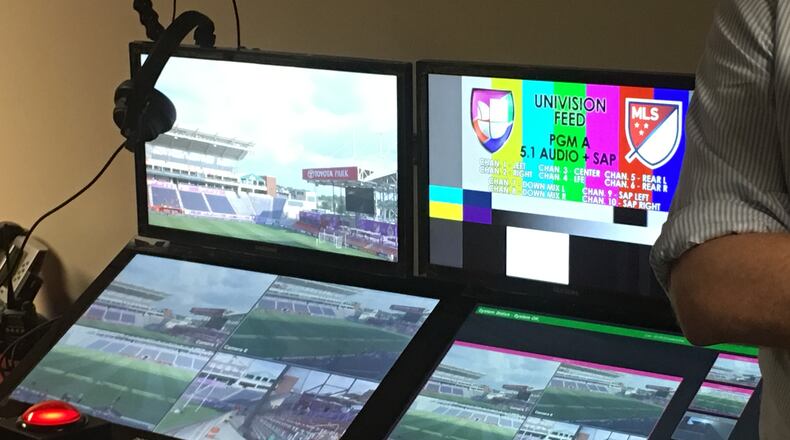The room is stifling, with only a floor fan to move the air around. But the focus isn’t on why the bay doors aren’t open on a summer Chicago day.
Instead, eyes are seduced by the big red button sitting just in front of four computer screens. No, the button doesn’t launch nuclear warheads, but its bright color and comical size does scream “push me.” Some soccer purists would argue its purpose may be the equivalent of a missile-driven meltdown.
The big red button may become the face of the video assistant referee system, or VAR, which will be put into place in MLS starting with this weekend’s games, including Atlanta United at Sporting KC.
Similar to systems used by the NFL, NBA, MLB and NHL, referees in MLS now will have help ensuring not that every one of the 250-300 decisions they make during a game are 100-percent accurate. Instead, the video assistant referee system will try to make sure that their decisions weren’t clearly wrong.
“We are excited about this project,” Howard Webb, a former referee in England’s Premier League who is now the face of VAR, said. “We feel this is going to be an additional tool for our officials to avoid making clear errors or to deal with certain missed incidents.
“It’s not going to change the way the game is played. If it does that, it’s not doing the job it’s meant to do. The game is beautiful. We love it for what it is.”
The International Football Association Board and FIFA approved the use of video review on a two-year trial basis in March 2016. MLS and the Professional Referee Organization worked with IFAB on clarifying the scope of VAR.
VAR can review four match-changing situations:
- Goals.
- Penalty/No Penalty.
- Direct red cards.
- Mistaken identity.
Each of the 22 MLS stadiums have been outfitted with the VAR technology. Webb said he has “intensively” trained almost 50 people in the past five months, which included its use in 135 games through Monday.
The technology includes four large touch screens, a camera, a communication device, a laptop, one green button, and the big red button in the VAR room. There is another monitor on the field for the game’s referee to use to review calls.
Three people work the technology sitting in a room in the stadium.
Two of the touchscreens include views from the minimum eight cameras used during every MLS broadcast. Those are the only views that the video assistant referee crew can use.
During the game, should the video assistant referee see a play that they think should be reviewed, they hit the red button and the play comes up on the screen on the left. A timer also pops up as a visual reminder to keep things moving, and a log. As the video assistant referee is reviewing that play, his assistant, seated to his left, continues to watch the game. Should they see something that needs to be reviewed, they will hit the green button, which will bookmark the video feed at the spot of the questionable play.
“We wanted it to be an active motion to actually initiate something so that people are actively engaged in the process,” James Japhet, managing director of Hawk-Eye in North America and the tour guide of the VAR technology, said. “Instead of, (mumbles) ‘I’ll check it.’
“If you can remove any communication issue and have a visual cue, you are always likely to get a result quicker and better, or at least that’s what we’ve found in several hundred games.”
To maintain the integrity of what is occurring in the room, activity is taped by a camera which faces those facing the computers. Japhet said certain pieces of footage related to reviews must be sent to IFAB and MLS.
The technology used for the reviews is used in 24 sports, according to Japhet. The process of the buttons, the interface and the layout is soccer-specific and designed in the past three years through working with different soccer federations, a “shed-load” of referees and hours of fine-tuning.
So, the button is pressed. A play is under review. It will be shown by the best camera angles and in a loop at full speed.
If the video assistant referee thinks the on-field referee should consider reviewing the play, the assistant will signal the ref. The referee has the option to shrug off the recommendation and let their call (or no-call) stand without review. Or the on-field referee can independently choose to see a play again.
As soon as there is a stop in play – either at the on-field referee’s recommendation or naturally -- they will signal there is a video review ongoing by holding up their hand. If the referee decides that he is following the video assistant referee’s recommendation to review the play, they will make a rectangular, or TV-shaped, motion with their index fingers. The stadium public-address announcer must also tell those attending that there is a play under review.
The on-field referee will come over to a monitor located near midfield and review the play. Should the ref feel a correction is necessary the appropriate action will be taken, and play will be restarted by making the same TV-shaped motion.
Webb said he could see teams kicking the ball out of bounds to stop the play to allow the referee to review a play. If play isn’t going to stop, the referee can stop the play for a review. Or a player might try to get play started as quickly as possible to get the game restarted and avoid the chance for a review.
MLS players and managers have received training on what to expect and how the system works.
It’s important to note that the video assistant referee can’t make a call that stands. That person can only offer the suggestion to review, or give advice. The referee must make the final call.
“He is still the referee,” Japhet said.
The technology has been used in some USL games, as well as the Confederations Cup.
It hasn’t been without its critics.
After a fight between players from Mexico and New Zealand in the Confederation Cup, the scuffle was reviewed by the on-field referee to see if any players deserved red cards.
Despite clear evidence of swings and elbows thrown, only yellow cards were issued, and two players who clearly engaged in red-card behavior didn’t receive any punishments. Those decisions set off a social-media storm of complaints against the VAR system.
Another of the criticisms of the use of VAR was that it would lengthen the game and disrupt the flow. All time spent on reviews is added to stoppage time.
In a sample size of 90 matches that used VAR there were 701 plays “checked,” which means they were match-changing plays considered for reviews. That was an average of 8.9 per game. Of those 701 checks, 26 were reviewed, or an average of 0.36 per game.
“It’s not this huge impact that we sometimes feared it might be, or some people did,” Webb said.
In games that didn’t use VAR, the average amount of time from a whistle calling a foul to the game’s restart took 1:25 in an MLS study conducted in 2014. On the 26 plays reviewed by the VAR system, from the check to recommendation to on-field review and restart of play took 2:41.
“Yes, it does take a bit more time with video review, but we feel it’s a price worth paying to get to a decision that’s not a clear error,” Webb said.
Webb feels that time will decrease as people grow accustomed to the technology.
“We’ve worked hard and feel they will get even better,” Webb said.
About the Author
Keep Reading
The Latest
Featured




